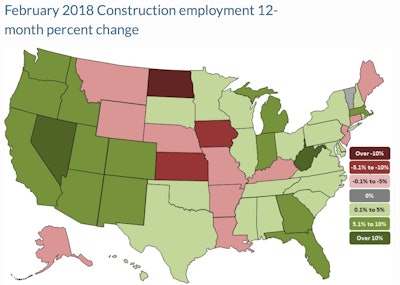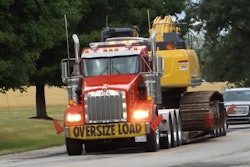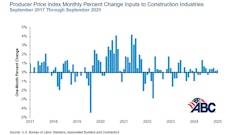
Thirty-five states and the District of Columbia added construction jobs between February 2017 and February 2018, while 38 states added construction jobs between January and February, according to an Associated General Contractors of America analysis of Labor Department data. Association officials praised the latest Congressional spending bill for funding career and technical education to help young workers get into the industry.
“The construction industry continues to add employees in most of the nation, despite a shortage of workers with construction experience,” said chief economist Ken Simonson. “But job openings are growing, as contractors encounter a shrinking pool of experienced jobseekers.”
California added the most construction jobs (74,000 jobs, 9.8%) during the past year. Other states adding a high number of new construction jobs for the past 12 months include:
- Texas (33,900 jobs, 4.8%)
- Florida (31,700 jobs, 6.3%)
West Virginia added the highest percentage of new construction jobs during the past year (14.3%, 4,300 jobs), followed by:
- Nevada (10.9%, 8,900 jobs)
- California (9.8%, 74,000 jobs,)
- Idaho (9.3%, 4,100 jobs)
- Arizona (9.2%, 13,000 jobs)
- New Mexico (9%, 4,000 jobs).
Fourteen states shed construction jobs between February 2017 and February 2018, while construction employment was unchanged in Vermont. North Dakota lost the highest percentage of construction jobs, by far (-16.3%, -4,800 jobs) followed by:
- Iowa (-8.5%, -6,700 jobs)
- Kansas (-5.3%, -3,300 jobs)
- Nebraska (-4.2%, -2,200 jobs)
Iowa lost the largest number of jobs, followed by North Dakota, Missouri (-4,000 jobs, -3.2%) and Kansas.
“The states with the largest job gains were all recovering from natural disasters, while losses were concentrated in the Plains states,” Simonson commented. “The Plains states have been hurt by a downturn in farm-related income.”
Thirty-eight states added construction jobs between January and February. New York added the most (7,700 jobs, 2%) followed by:
- Florida (7,100 jobs, 1.4%)
- California (6,800 jobs, 0.8%)
Connecticut added the highest percentage of construction jobs for the month (2.6%, 1,500 jobs) followed by:
- Mississippi (2%, 900 jobs)
- Indiana (2%, 2,800 jobs)
- New York (2%, 7,700 jobs)
Eleven states lost construction jobs between January and February, while construction employment was unchanged in Alabama and D.C. Washington state lost the most construction jobs for the month (-1,500 jobs, -0.7%) followed by:
- Alaska (-800 jobs, -5.%)
- Kansas (-700 jobs, -1.2%)
Alaska lost the highest percentage of construction jobs, followed by Montana (-2.1%, -600 jobs) and Kansas.
Association officials said the widespread job gains show that construction offers good career opportunities and that public agencies at all levels of government should do more to improve the career and technical education pipeline. They praised the funding increases passed by Congress on Thursday for programs to assist students and underemployed adults gain the skills needed for jobs in construction.
“Rebuilding career and technical education programs is essential for helping the economy expand and assure a supply of qualified construction workers,” said Stephen E. Sandherr, the association’s chief executive officer. “The funding bill that Congress approved on Thursday is a good step in that direction.”



















